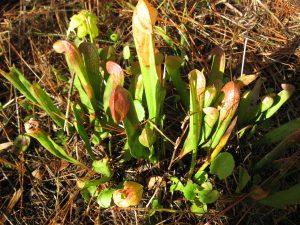
Bill Black and Denise Matthews purchased their 80-acre Sparkleberry Farm property in November 2010. Their goal was to transform the neglected stands of pine, cypress, and hardwoods into a more productive and sustainable condition for timber production, recreation, and native flora and fauna. To accomplish this they have, and continue to use forestry practices that enhance the native, fire-dependent ecosystem, including the use of mechanical understory reduction, prescribed fire, control of invasive species, and restoration planting of longleaf pine and wiregrass in forest openings. Hardwood swamps on the property are retained and protected above and beyond the standards of silviculture Best Management Practices, and slash pines are retained around the swamp margins, providing some fuel to carry fire into those areas. Where safe to do so, lightning-killed pines are retained for woodpeckers as a food source and nesting.
Bill and Denise also appreciate and research the history of the area and the property. In early 1900s the property was owned by the Earle family, which leased the property for turpentine production and logging. The property was never farmed so many pieces of the pine resin-collecting Herty pots have been found on the property.
They have worked with the Florida Forest Service (FFS) and Florida Fish & Wildlife Conservation Commission (FWC) to develop a Forest Stewardship Management Plan, and cost-share programs of the USDA Natural Resources Conservation Service (NRCS) have helped to defray the cost of several management practices on the property. They work with Jowett & Wood Consultants to conduct forest inventories, thinning, and harvesting operations in the timber stands. FFS fire teams have also been used to conduct prescribed burns, and the FWC’s Landowner Assistance Program (LAP) has provided habitat improvement assistance and support. The property is certified in the American Tree Farm System and Forest Stewardship Program.

As a result of their regular use of prescribed fire, they are noting an increased abundance of unique and rare plants such as orange-fringed orchids (Platanthera ciliaris) as well as wiregrass and species of pitcher plants in the wetter areas. Many game and non-game wildlife species are seen on the property. Retained dead trees (snags) have provided food and nesting for numerous pileated woodpeckers.
Engagement with conservation and environmental organizations and programs is an important part of earning recognition as an exemplary Land Steward. For the last 4 years, Bill has participated in the Audubon Society’s Christmas bird count. Thirty-three species and a total of 324 individuals were logged in the 2021 count. He has also supervised several University of Florida undergraduate forestry students in hardwood and invasive species control, longleaf pine and wiregrass seedling planting, fence building, gopher tortoise burrow locating, and property maintenance. Two of the students received training in operating a compact track-loader with a brushcutter.

Bill has also been a land steward ambassador to the public and fellow landowners. In 2015 he hosted a Forest Stewardship Tour at Sparkleberry Farm where he effectively communicated his stewardship journey, the management practices he has used, challenges experienced along the way and how he addressed them, and sources of assistance. He maintains regular communications with forestry and natural resource partners and continues to encourage University of Florida researchers and students to visit the property to observe and record rare plants.
After continuous, active management with prescribed fire and other land management practices, the Sparkleberry Farm is now home to abundant wildlife; including gopher tortoises, deer, turkey, and quail; longleaf pine, naturally regenerated slash and loblolly pine stands, hardwood swamps, and a rich groundcover of unique and rare plants. Bill and Denise look forward to continuing their stewardship journey at Sparkleberry Farm and beyond by encouraging research and education, and taking opportunities to promote land stewardship to fellow landowners and the public.
 1
1
